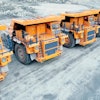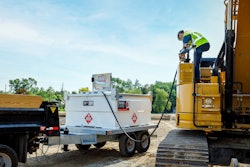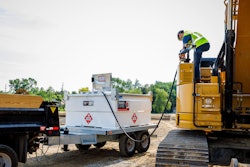
By Barry Truan, Western Global general manager North America
Diesel is the source of roughly 98% of energy consumed at the average jobsite and is practically a universal expense for contractors. As the construction industry changes and companies become more competitive globally, profit margins will continue to shrink for businesses that don’t find new and efficient ways to manage assets, including fuel storage.
Today, on-site tanks can simplify fuel management like never before and serve as more of an asset than the large steel cylinders they once were. To make the most of a fuel tank purchase, there are a number of factors to consider, such as the benefits of fuel monitoring, cleaning and maintenance costs, tank transportation, theft prevention and more.
Capacity and Mobility
 Remote fuel management systems can help employers monitor dispensing and reduce fuel theft.
Remote fuel management systems can help employers monitor dispensing and reduce fuel theft.
The most easily transported options are smaller, DOT-approved trailer-mounted tanks. These tanks typically hold between 200 and 1,000 gal. and are suited for delivering fuel to remote sites. Some of the more important items to look for when buying a trailer-mounted tank include a sturdy trailer engineered to withstand the dynamic forces of the moving liquid while navigating rough, unpaved roads at jobsites. Tanks designed to comply with worldwide approvals, including UL, ULC, UN/DOT and Transport Canada, are usually the most rugged and well-designed, as they are required to pass the rigorous testing and certification dictated by the various approval bodies.
Keep in mind, however, that just because a tank is approved, does not necessarily mean it’s the safest option. A lower center of gravity, for example, will make the tank less susceptible to tipping during transport. For full fuel transport, internal baffle plates prevent fuel surging to keep the vehicle stable. In most locations, tanks without baffles must be emptied, and often cleaned, prior to transport, which can require a third-party environmental company. If the tank is moved frequently, downtime and expenses add up quickly.
If the job requires a larger tank of 1,000 gal. or more, consider how it will be moved around a jobsite. Round tanks often require a crane or loader to move. Most cube tanks can also be moved this way, but for added versatility, many also incorporate forklift pockets. Having more options can come in handy when equipment operators are busy or if certain equipment isn’t on the jobsite.
Simplify Compliance
Ground contamination is a major concern for on-site fuel tanks. While all tanks should meet basic environmental standards, round tanks — the traditional go-to storage option — come with the added expense of owning and cleaning secondary containment pans. The average bill for cleaning a containment pan is about $150, which can add up quickly in areas that require pans be cleaned on a regular basis or after it rains.
An increasingly common feature on new tanks, particularly cube tanks, is double-walled 110% weatherproof containment. This eliminates the need for a secondary basin and can result in significant savings over the life of a tank.
Diesel exhaust restrictions are another growing environmental concern for today’s business owners. To ease the burden of Tier 4 compliance, many manufacturers offer tank options with onboard DEF storage. Incorporating both diesel and DEF storage into a single tank reduces downtime and simplifies compliance.
Site-specific Considerations
 Western Global’s Fuel Island is a self-contained, moveable fuel station that can be deployed for fleet refueling as well as long-term, stationary applications.
Western Global’s Fuel Island is a self-contained, moveable fuel station that can be deployed for fleet refueling as well as long-term, stationary applications.
For jobs at remote locations, remote fuel tracking can help you monitor and manage supplies from anywhere via the cloud. If you have multiple projects at different sites, this can make it easy to stay on top of fuel supplies and know when a delivery is necessary.
For improved tracking and added security, cardlock systems are an efficient way to monitor who is pumping fuel and how much is dispensed. Businesses without fuel security often expect 2% to 5% of their fuel supply will go unaccounted for each year. For example, a contractor using 20,000 gal. of dyed diesel per week may lose as much as 1,000 gal. per week if 5% is unaccounted for. At $2.50/gal., that’s a $2,500 loss each week, or $130,000 each year, as a result of not closely monitoring fuel use. By tracking with a cardlock system, employers can easily monitor dispensing and greatly reduce losses by preventing employees and others from filling personal vehicles.
Having tanks with secure access to fittings and dispensing equipment can also prevent unauthorized access and deter fuel theft. While many rely on regular padlocks, these are easy to cut and do little to deter thieves. Investing in more secure cabinets that position locks to be inaccessible to bolt cutters will better keep thieves at bay. While these security features will likely bump up the initial tank price, preventing a single theft of 50 gal.— roughly the capacity of a diesel pickup — may be enough to offset the difference.
Another location-specific consideration is the tank’s power supply. For mobile tanks and tanks at remote sites, adding options such as battery power storage and solar panels can help ensure that the tank will always have the necessary power to run the pumps. And for locations with space limitations, tanks that can be stacked help to free up space.
Fueling Additional Savings
 Special tanks designed for dispensing diesel exhaust fluid provide customers with a simple and secure solution for maintaining Tier 4-compliant equipment.
Special tanks designed for dispensing diesel exhaust fluid provide customers with a simple and secure solution for maintaining Tier 4-compliant equipment.
To extend the life of pumps, meters and other components, look for tanks with enclosed, weatherproof cabinets. This is a common feature on modern cube tanks and will greatly increase the longevity of components compared to tanks with components mounted on the top, where they are exposed to the elements.
Choose a manufacturer that works closely with its customers to help select the optimal tank or fleet for the size and scope of the operation. Some manufacturers will even go as far as partnering with a customer to ensure all regulations, from local to state and from EPA to DOT, are met. Also consider the manufacturer’s lead time. Some tanks can be on site within days, while others take weeks. While planning ahead is ideal, it’s not always realistic, and with short turnaround times, projects can get started sooner.
About the author: Barry Truan is North American general manager of Western Global, a provider of portable tanks and dispensing equipment for the safe storage and handling of fuels, lubricants, and other fluids.



















